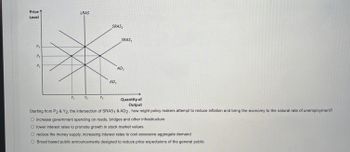
ENGR.ECONOMIC ANALYSIS
14th Edition
ISBN: 9780190931919
Author: NEWNAN
Publisher: Oxford University Press
expand_more
expand_more
format_list_bulleted
Question
Please help solve

Transcribed Image Text:### Understanding Aggregate Demand and Supply Graphs
**Graph Explanation:**
The given graph illustrates the relationships between the price level and the quantity of output in an economy using aggregate demand (AD) and short-run aggregate supply (SRAS) curves.
- **Axes:**
- The vertical axis represents the **Price Level**.
- The horizontal axis represents the **Quantity of Output (Real GDP)**.
- **Curves:**
- **LRAS (Long-Run Aggregate Supply):** A vertical line indicating the economy's natural rate of output, where the economy produces at full employment, labeled here as \( Y_2 \).
- **SRAS (Short-Run Aggregate Supply):** Two upward sloping curves. The initial SRAS is labeled as \(\text{SRAS}_1\), and a rightward shifted SRAS is labeled as \(\text{SRAS}_2\).
- **AD (Aggregate Demand):** Two downward sloping curves. The initial AD is labeled as \(\text{AD}_1\), and a rightward shifted AD is labeled as \(\text{AD}_2\).
- **Equilibrium Points:**
- The initial equilibrium is where \(\text{SRAS}_1\) intersects \(\text{AD}_1\) at price level \(P_1\) and output level \(Y_1\).
- The new intersection of \(\text{SRAS}_1\) and \(\text{AD}_2\) is at price level \(P_2\) and output level \(Y_2\).
- Another possible intersection of \(\text{SRAS}_2\) and \(\text{AD}_2\) could be considered.
**Question and Options:**
The question posed below the graph is:
"Starting from \(P_2\) & \(Y_2\), the intersection of \(\text{SRAS}_1\) & \(\text{AD}_2\), how might policymakers attempt to reduce inflation and bring the economy to the natural rate of unemployment?"
Here are the policy options provided for achieving these economic objectives:
1. **Increase government spending on roads, bridges and other infrastructure**
2. **Lower interest rates to promote growth in stock market values**
3. **Reduce the money supply, increasing interest rates to cool excessive aggregate demand**
4. **Broad based public announcements designed to reduce
Expert Solution
This question has been solved!
Explore an expertly crafted, step-by-step solution for a thorough understanding of key concepts.
Step by stepSolved in 2 steps

Knowledge Booster
Learn more about
Need a deep-dive on the concept behind this application? Look no further. Learn more about this topic, economics and related others by exploring similar questions and additional content below.Similar questions
- How inflation starts in an economy? Use diagrams where necessary?arrow_forwardcan you please explain step 4 again, I can't see whats written there.arrow_forwardHow does health, wealth, and happiness of an economy might tie into the business world or be important to know from a business perspective?arrow_forward
Recommended textbooks for you

 Principles of Economics (12th Edition)EconomicsISBN:9780134078779Author:Karl E. Case, Ray C. Fair, Sharon E. OsterPublisher:PEARSON
Principles of Economics (12th Edition)EconomicsISBN:9780134078779Author:Karl E. Case, Ray C. Fair, Sharon E. OsterPublisher:PEARSON Engineering Economy (17th Edition)EconomicsISBN:9780134870069Author:William G. Sullivan, Elin M. Wicks, C. Patrick KoellingPublisher:PEARSON
Engineering Economy (17th Edition)EconomicsISBN:9780134870069Author:William G. Sullivan, Elin M. Wicks, C. Patrick KoellingPublisher:PEARSON Principles of Economics (MindTap Course List)EconomicsISBN:9781305585126Author:N. Gregory MankiwPublisher:Cengage Learning
Principles of Economics (MindTap Course List)EconomicsISBN:9781305585126Author:N. Gregory MankiwPublisher:Cengage Learning Managerial Economics: A Problem Solving ApproachEconomicsISBN:9781337106665Author:Luke M. Froeb, Brian T. McCann, Michael R. Ward, Mike ShorPublisher:Cengage Learning
Managerial Economics: A Problem Solving ApproachEconomicsISBN:9781337106665Author:Luke M. Froeb, Brian T. McCann, Michael R. Ward, Mike ShorPublisher:Cengage Learning Managerial Economics & Business Strategy (Mcgraw-...EconomicsISBN:9781259290619Author:Michael Baye, Jeff PrincePublisher:McGraw-Hill Education
Managerial Economics & Business Strategy (Mcgraw-...EconomicsISBN:9781259290619Author:Michael Baye, Jeff PrincePublisher:McGraw-Hill Education


Principles of Economics (12th Edition)
Economics
ISBN:9780134078779
Author:Karl E. Case, Ray C. Fair, Sharon E. Oster
Publisher:PEARSON

Engineering Economy (17th Edition)
Economics
ISBN:9780134870069
Author:William G. Sullivan, Elin M. Wicks, C. Patrick Koelling
Publisher:PEARSON

Principles of Economics (MindTap Course List)
Economics
ISBN:9781305585126
Author:N. Gregory Mankiw
Publisher:Cengage Learning

Managerial Economics: A Problem Solving Approach
Economics
ISBN:9781337106665
Author:Luke M. Froeb, Brian T. McCann, Michael R. Ward, Mike Shor
Publisher:Cengage Learning

Managerial Economics & Business Strategy (Mcgraw-...
Economics
ISBN:9781259290619
Author:Michael Baye, Jeff Prince
Publisher:McGraw-Hill Education